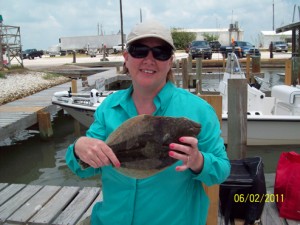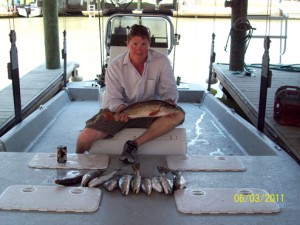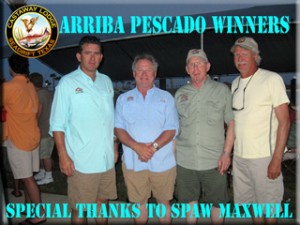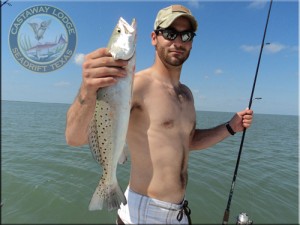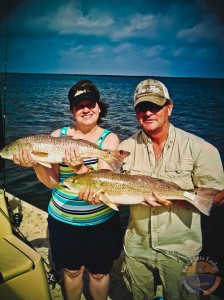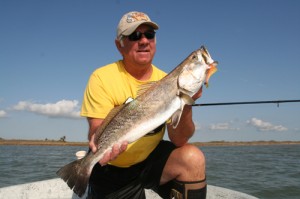
The big trout ate a red and yellow Wedgtail Mullet fished over grass that was swarming with mullet last week. -Robert Sloan photo
Over the past couple of weeks I’ve had the opportunity to fish from Sabine Lake to the Lower Laguna Madre and during that time I used a passel of lures to catch trout up to the 7 pound mark. One thing that I’ve found to be true for many years, especially here in Port O’Connor, is that when in doubt whip the soft plastic out.
Recently I was fishing with Capt. Bruce Shuler out of Port Mansfield. The first afternoon on the water four of us were out on the Laguna and wade fishing in about three feet of gin clear water. The only malfunction was that the wind was blowing a gale. I’m thinking the afternoon fishing jaunt was blown out. That is until Shuler tossed a new soft plastic my way. It’s called Wedgetail Mullet and is part of the all new Egret Saltwater line of baits.
“That’s a swimmer, or better known as a swim bait,” said Shuler. “It’s simple to use and will catch trout in just about any situation.”
I’m not that keen on swim baits of any type. That’s mainly because I have no confidence in them. The first rule of thumb when using a lure is to have confidence in the bait.
I tied on the 5-inch long Wedgetail Mullet, slipped out of the boat to begin a wade on the white-capped flat. This ain’t no lie. Within about 45 minutes my new swim bait had caught a dozen trout to about 3 pounds. This particular soft plastic is 5 inches long, and it can be rigged on a conventional lead head jig, or with a SwimMax 6/0 hook. We ended up fishing them both ways last week. Much of that time we were fishing in some pretty thick vegetation. When the Wedgetail is rigged on a SwimMax hook it’s weedless. The hook comes with a VLock screw in the center of the nose. You take the lure and twist it up on the screw, then slide the point of the hook up through and out the back of the bait. It’s simple and will not hang up on weeds.
I’ve never seen a simpler bait to fish. Once it’s rigged you simply cast it out and reel it in on a slow and steady retrieve. On my first wade with this lure the trout were shooting out of the grass and thumping it pretty good. We ended up catching both reds and trout on Wedgetail Mullets in a variety of colors. The best seemed to be red over yellow and chartreuse over white.
What makes this particular soft plastic so good is the signature Wedgetail. It’s a fat wedge of plastic that produces a very tight thumping motion.
Another new soft plastic I’ve used with good success lately is the Bayou Chub. This is a 3.5 inch minnow-shaped lure that’s built with a round paddle tail. This past Sunday I used a copper Bayou Chub with a chartreuse tail to catch an easy limit of reds that were feeding in brackish colored water on a backwater estuary lake out of Port O’Connor. We had rigged the tails on 1/8 ounce lead head jigs.
Many fishermen along the Texas coast like to use the sickle-tailed soft plastics on a fast jerk/jerk/jerk retrieve. The paddle tail jigs seem to work best on a slow and steady retrieve. It’s the thumping tail that gets the attention of trout and reds.
Believe it or not there’s a lot of difference in the lead heads that jigs are rigged on. They come in all sorts of colors, sizes and have various hook sizes and styles. I fish with a lot of professional anglers and guides and just about all of them agree that an unpainted jig head is best. Egret Bait Company has just come out with a jig head that’s pretty much close to perfect. The lead heads are not painted and have a pair of bright red eyes. Plus they are mounted on high quality hooks. Right behind the lead head are two ribs that hold the soft plastics snug without any slippage. They are made in 3/16, 5/16, 7/16 and ½ ounce sizes. The 3/16 ounce head is perfect for most fishing situations in Port O’Connor. The reason why is simple – you want a slow falling soft plastic while fishing on places like Pringle and Contee lakes. What you don’t want to do is fish a fast falling jig that retrieves a wad of grass.
The newest and hottest soft plastic jig color for reds is a copper/glitter finish. An olive/green or white/chartreuse is usually best for trout. The LSU color pattern is good for both reds and trout on most days in Port O’Connor.
For details on fishing with Capt. Robert Sloan call 409 782 6796. Or check out his web site at www.hightailangler.com.
